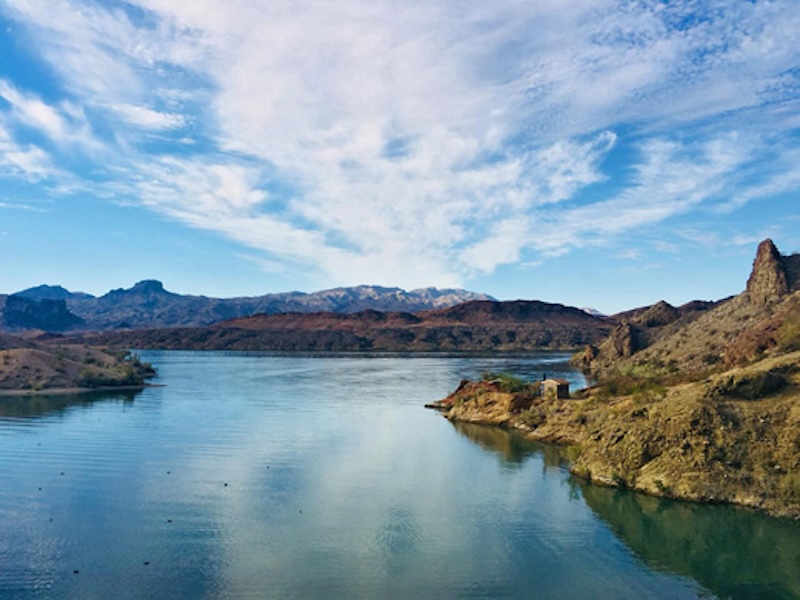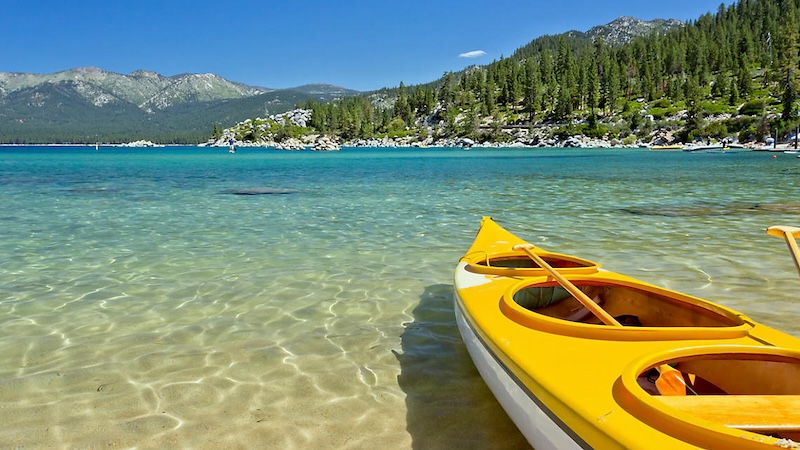
Big Bear Lake 2025: the complete outdoor explorer's handbook
There's something about Big Bear Lake that pulls you in. The scent of pine trees, the sparkle of morning light on water, that first breath of cool mountain air. Nestled in Southern California's San Bernardino Mountains, this alpine lake has become our go-to escape when city life feels too constricting.
We created this handbook for fellow nature lovers who want to experience Big Bear beyond the tourist traps. Whether you're planning to cool off with a summer swim, discover trails that locals actually hike, or find a quiet cove for paddling, we'll guide you through the experiences that make this mountain lake worth the journey.
Pack your curiosity (and maybe a swimsuit) — let's explore what makes Big Bear Lake a perfect outdoor playground in every season.
Key takeaways from our Big Bear Lake guide
Big Bear Lake offers year-round outdoor adventures from swimming and paddling in summer to hiking amid fall colors, skiing in winter, and wildflower viewing in spring
The lake sits at 6,750 feet elevation in the San Bernardino Mountains, creating a refreshing alpine escape just 2-3 hours from Los Angeles and San Diego
Swimming spots like Big Bear Lake Swim Beach and Boulder Bay Park provide family-friendly access to the lake's crystal-clear waters during warmer months
Beyond the popular areas, quiet corners like Bluff Lake Reserve and Hanna Flat Campground offer more secluded nature experiences away from the crowds
Where is Big Bear Lake?
Big Bear Lake nestles in the San Bernardino Mountains of Southern California, creating a perfect mountain getaway for nature lovers and outdoor enthusiasts seeking clean air and alpine scenery.
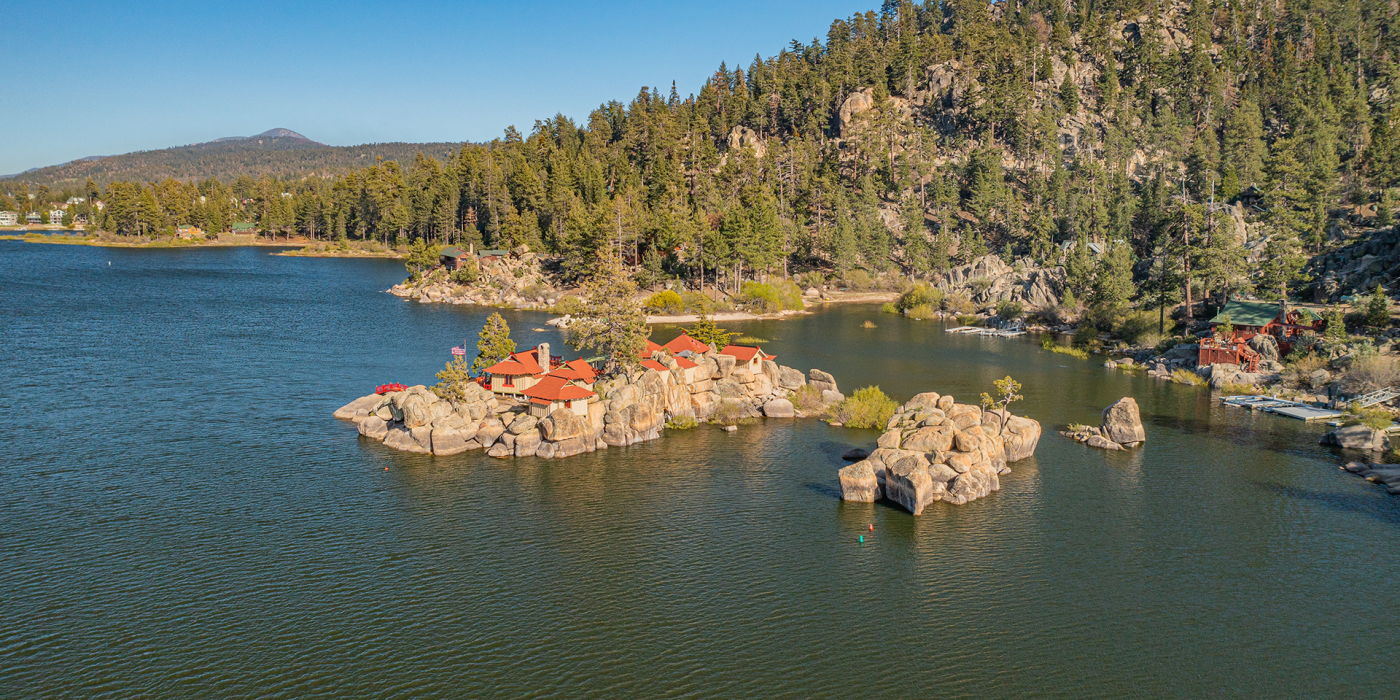
Geographic location and setting
Tucked into the San Bernardino National Forest, Big Bear Lake sits about 100 miles northeast of Los Angeles and 140 miles northeast of San Diego. At 6,750 feet elevation, the lake offers a refreshing mountain escape from Southern California's heat. The lake exists thanks to the Big Bear Lake Dam, built back in 1884.
Pine forests and mountain peaks frame the clear blue waters, creating a postcard-worthy alpine setting. Stretching 7 miles long and 2.5 miles wide with 22 miles of shoreline, the lake welcomes anglers, boaters, and swimmers during warmer months. Several mountain creeks feed into the lake, keeping it fresh and flowing.
The town of Big Bear Lake runs along the south shore, serving as the main visitor hub with places to eat, sleep, and gear up for adventures. For those seeking quieter experiences, the north shore remains less developed, offering more secluded access to nature.
How to get there from major cities
Reaching Big Bear Lake requires a scenic mountain drive from any of Southern California's major cities.
From Los Angeles: Take Interstate 10 east to Redlands, then head north on State Route 30 to Running Springs. From there, follow State Route 18 east to Big Bear Lake. The journey typically takes 2 to 2.5 hours, depending on traffic and weather conditions.
From San Diego: Follow Interstate 15 north to Devore, then Interstate 210 east to San Bernardino. Continue on State Route 330 north to Running Springs, then State Route 18 east to Big Bear Lake. Allow 3 to 3.5 hours for this drive.
From Las Vegas: Drive south on Interstate 15 to Barstow, then take State Route 247 south to Lucerne Valley. Finally, follow State Route 18 east to Big Bear Lake – about a 4.5 to 5-hour journey.
Why visit Big Bear Lake?
Big Bear Lake is more than just a scenic destination—it's where memories are made in the wild. Here's why this mountain oasis deserves a spot on your travel map, whether you're packing up the family van for a weekend escape or searching for a solo adventure that brings you back to what matters.
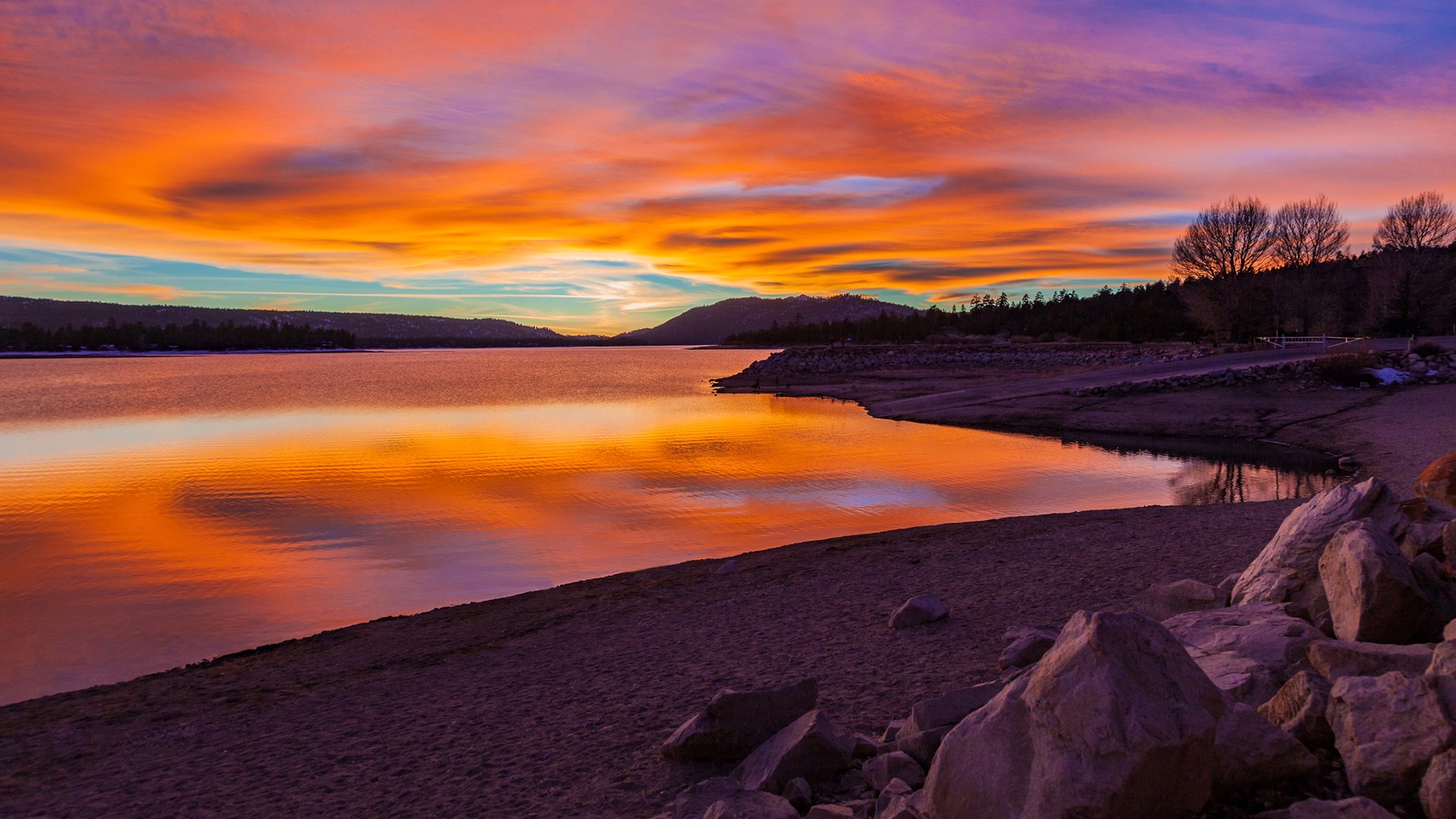
Natural beauty and alpine setting
Big Bear Lake sits cradled in the San Bernardino National Forest, where pine-scented air meets a backdrop of rugged mountain peaks. The lake's clear waters mirror the surrounding forest and sky—a natural canvas that shifts with the light and weather, but always remains stunning.
At 6,750 feet elevation, the alpine setting offers what Southern California rarely provides: genuine mountain coolness, especially welcome during scorching summer months. The fresh air alone is worth the drive up the mountain.
With 22 miles of shoreline to explore, you'll find everything from busy beaches to quiet coves where you can skip stones or simply sit in silence. The landscape invites both contemplation and adventure—often in the same afternoon.
Seasonal adventures for nature lovers
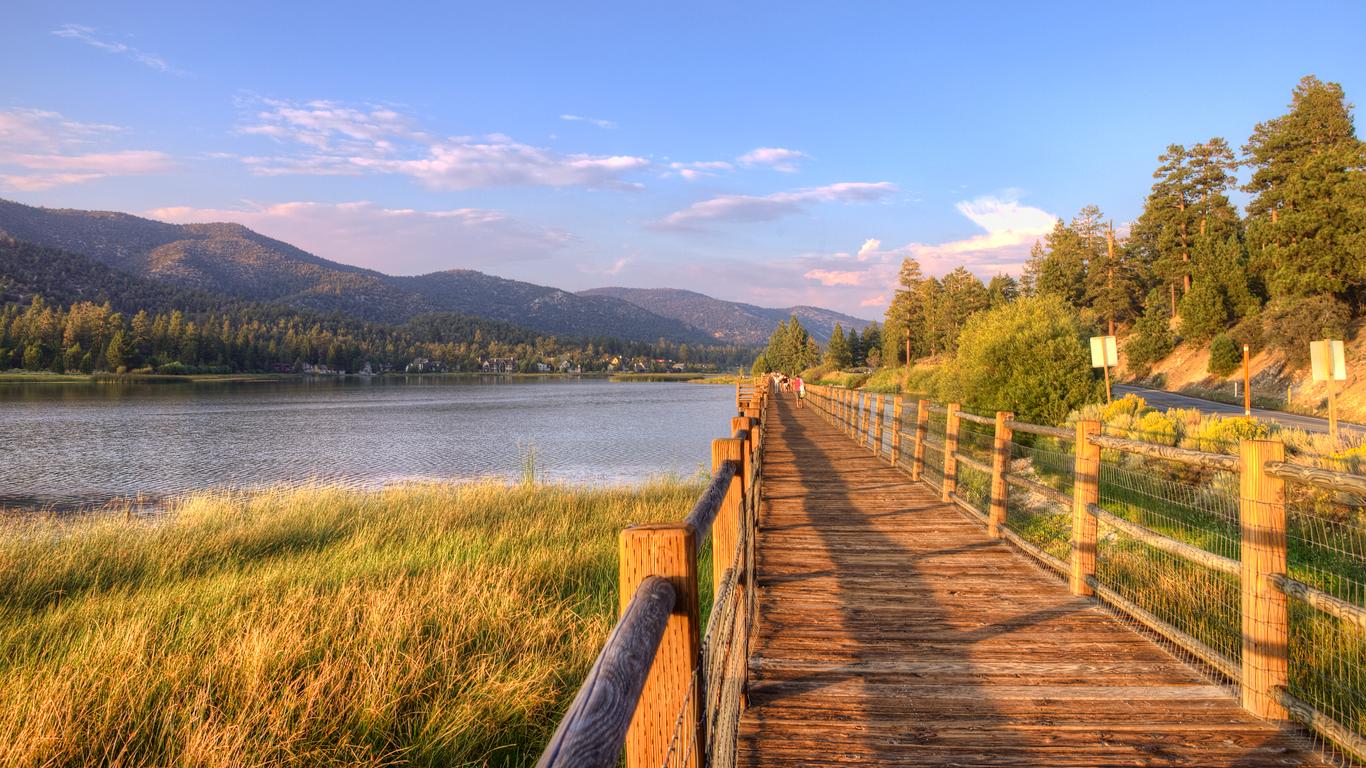
Big Bear is a true four-season destination, each offering its own version of outdoor magic.
Summer days center around the water—swimming in the cool lake, launching kayaks from quiet inlets, or paddleboarding across glassy morning waters before the afternoon breeze picks up. On land, hikers find trails for every ability, many rewarding you with sweeping lake views after a good climb.
Fall brings golden aspens and cooler temperatures, perfect for hiking without summer crowds. Morning mist rises from the lake, creating dreamlike scenes for photographers and early risers alike.
Winter transforms the mountains into a snowy playground. While Bear Mountain and Snow Summit draw skiers and snowboarders, you'll also find families ice skating and building snowmen along the frozen edges of the lake. The snow-dusted pines create a quieter, more contemplative landscape.
What makes Big Bear special isn't just what you can do there—it's how the place makes you feel: connected to something bigger than yourself, whether you're watching stars reflect on still waters or breathing deep on a forest trail.
Top outdoor activities at Big Bear Lake
Big Bear Lake is an outdoor lover's paradise, with activities that suit every interest and ability level. From cool dips in alpine waters to peaceful hikes with sweeping views, there's something for every nature enthusiast here. Let's explore the outdoor experiences that make this mountain lake so special.
Swimming spots worth seeking out
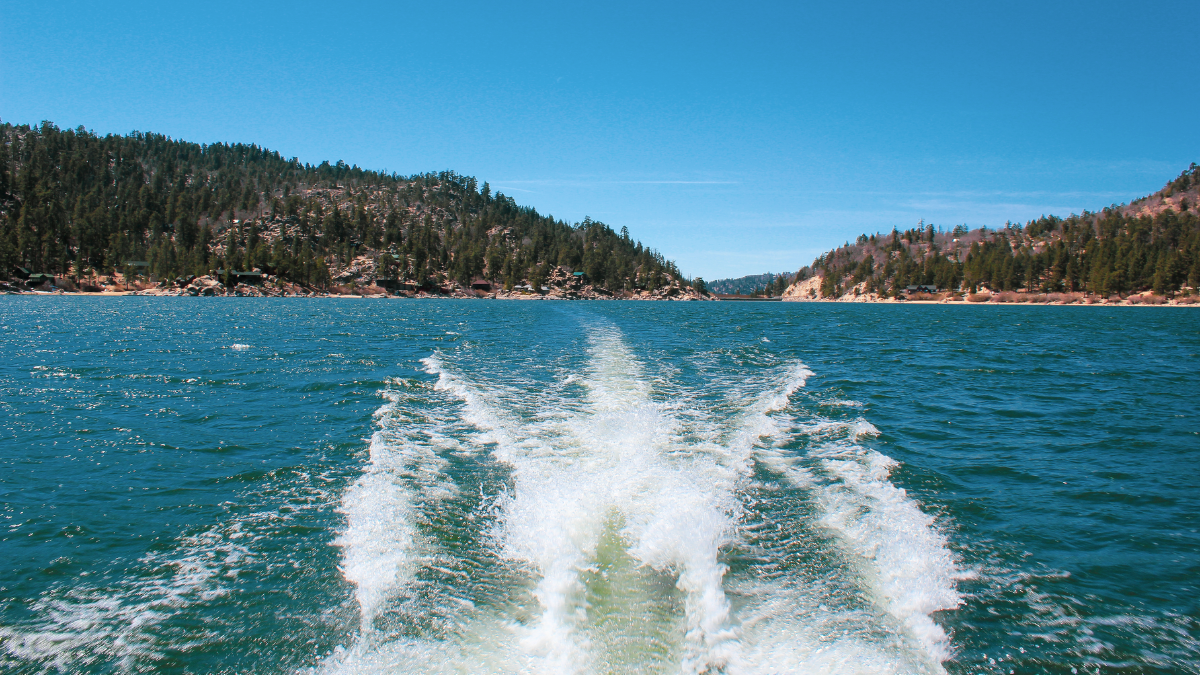
The crystal-clear waters of Big Bear Lake offer several inviting swimming spots, each with its own character. Big Bear Lake Swim Beach on the north shore provides a family-friendly experience with a sandy shoreline and lifeguards watching over swimmers during summer. You'll find picnic tables, restrooms, and a playground that makes it perfect for a day trip with kids.
For those seeking a quieter swim, Boulder Bay Park on the western shore delivers tranquil waters and a small, less crowded beach area. This peaceful spot comes complete with picnic areas and barbecue grills—ideal for a relaxed afternoon by the water.
Meadow Park on the south shore combines swimming with plenty of recreation options. The sandy beach and designated swimming area sit alongside grassy spaces perfect for spreading out a blanket. Volleyball courts and horseshoe pits offer extra fun when you need a break from the water.
Scenic hiking trails with lake views
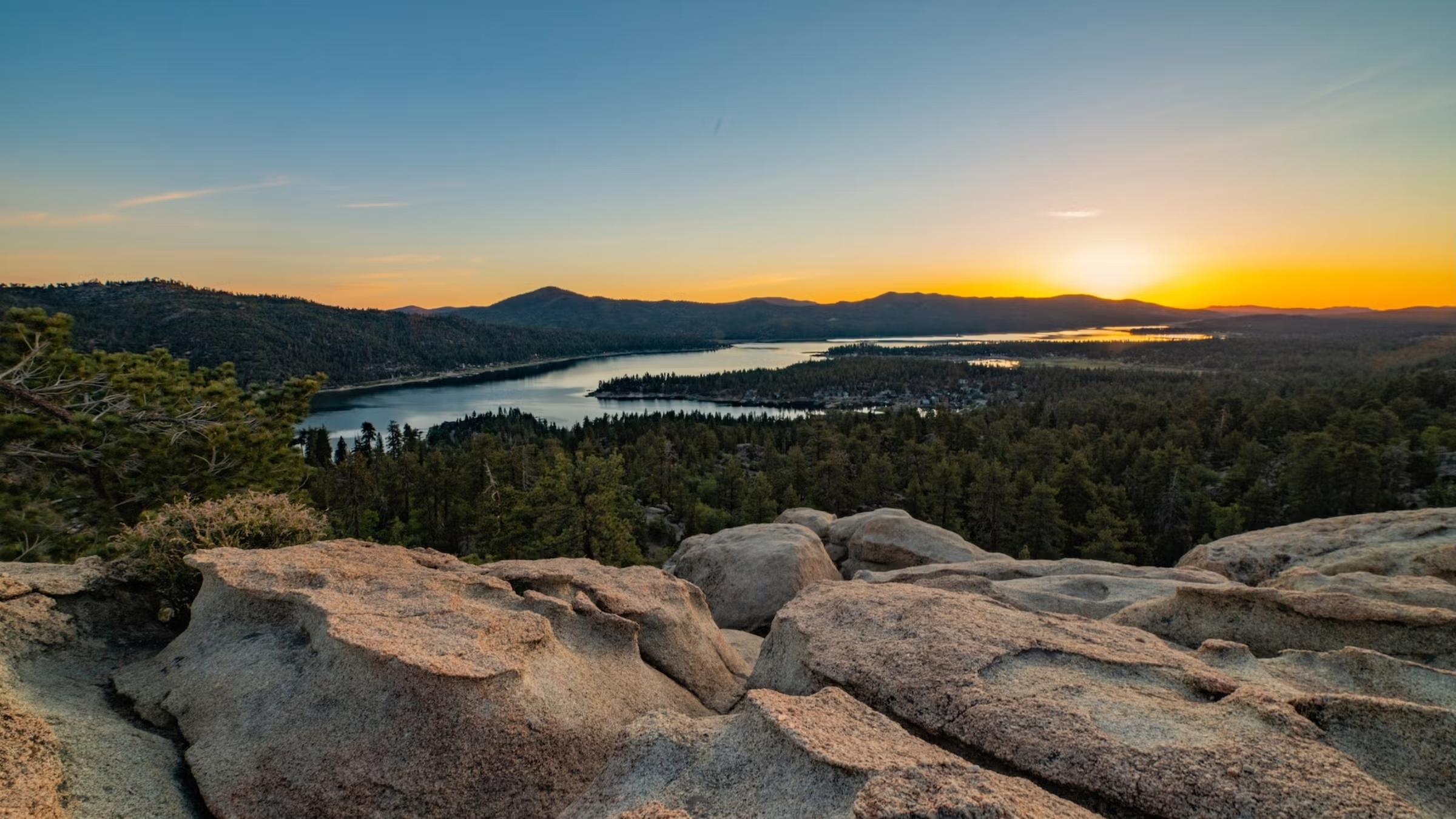
The mountains surrounding Big Bear Lake create a network of trails with breathtaking vistas. The legendary Pacific Crest Trail (PCT) traces the northern shoreline, rewarding hikers with sweeping panoramas of blue water against mountain backdrops. You can walk just a section for a taste of this famous trail.
For a shorter but memorable trek, the Castle Rock Trail packs incredible views into a 2.7-mile round trip. The path climbs to a distinctive granite formation that serves as a natural lookout over the entire valley. It's moderately challenging with some steep climbs, but the payoff is worth every step.
The Cougar Crest Trail offers another fantastic lake perspective along its 4.5-mile round-trip route. Starting near the Big Bear Discovery Center, this moderate trail winds through fragrant pine forest before revealing stunning views across the water to the mountains beyond.
Kayaking, stand-up paddling, and boating
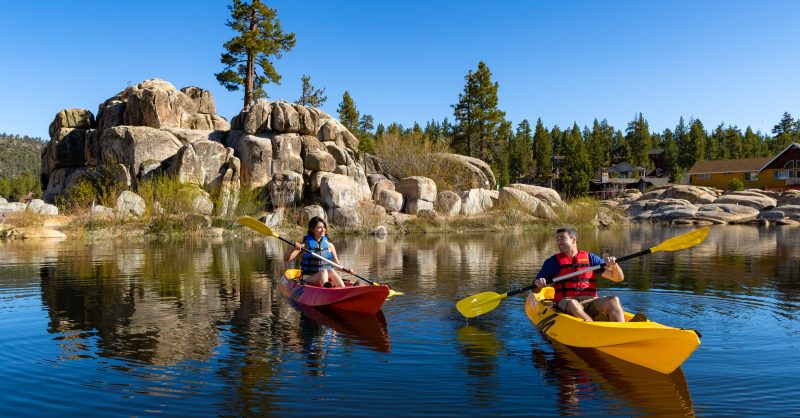
The calm, protected waters of Big Bear Lake create perfect conditions for paddling adventures. Kayaking here means gliding across mirror-like water, often with mountain reflections creating a sense of floating between two worlds.
Big Bear Marina serves as a great launching point for water exploration, offering everything from kayaks and SUPs to pontoon boats and fishing vessels for rent. Their friendly staff can point you toward quiet coves and scenic shorelines.
For a guided experience, join a stand-up paddleboarding tour with Action Tours Big Bear. Their knowledgeable guides take you to secluded spots while sharing stories about the lake's natural history and pointing out wildlife you might otherwise miss.
Discovering quiet corners and hidden gems
Despite its popularity, Big Bear still holds peaceful retreats away from crowds. Bluff Lake Reserve, just a short drive from the main lake, offers a 96-acre sanctuary with a smaller, more intimate lake setting. Wander its quiet trails through meadows filled with wildflowers in spring and summer.
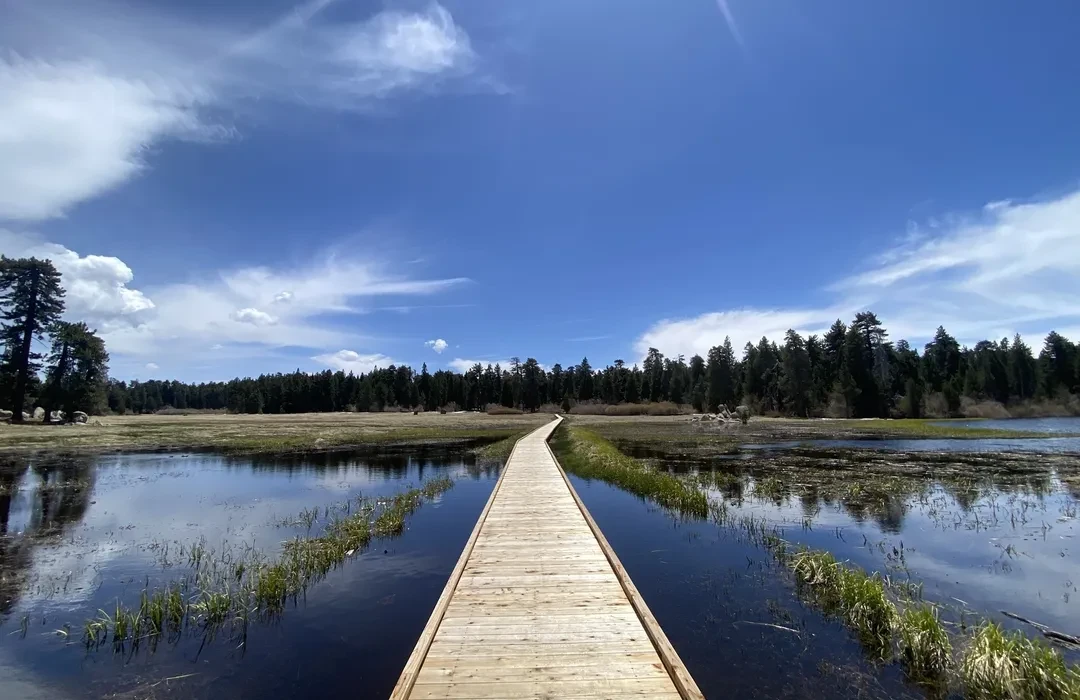
Holcomb Valley, tucked away northeast of Big Bear Lake, reveals California's gold rush history amid beautiful natural scenery. The valley's open meadows and pine forests invite exploration along hiking trails that pass abandoned mining sites and stunning rock formations.
For an overnight experience surrounded by nature, Hanna Flat Campground offers a secluded retreat beneath tall pines. The campground's peaceful atmosphere and access to less-traveled trails make it a favorite among those looking to experience the quieter side of Big Bear.
When to visit Big Bear Lake
Big Bear Lake transforms with each season, offering completely different experiences depending on when you visit. The rhythm of this mountain lake follows nature's calendar—creating distinct opportunities for swimming, hiking, and reconnecting with the outdoors throughout the year.
Perfect seasons for swimming, hiking, and more
Summer brings the busy season at Big Bear Lake, when the water beckons on hot days. From late June through August, water temperatures make swimming comfortable, while gentle mountain breezes create ideal conditions for kayaking and stand-up paddleboarding across the lake's surface. Summer mornings offer the best hiking weather before afternoon heat sets in—try the Pacific Crest Trail segments for lake views or the rocky scramble up Castle Rock Trail for a more challenging trek with panoramic rewards.
The quieter autumn months transform Big Bear into a canvas of golds and reds as aspen and oak leaves change. From late September through October, crisp mornings give way to sunny afternoons perfect for unhurried hikes when crowds thin out. The cooler temperatures make longer treks more comfortable, and the angled fall light creates stunning photo opportunities across the lake, especially in the golden hour before sunset.
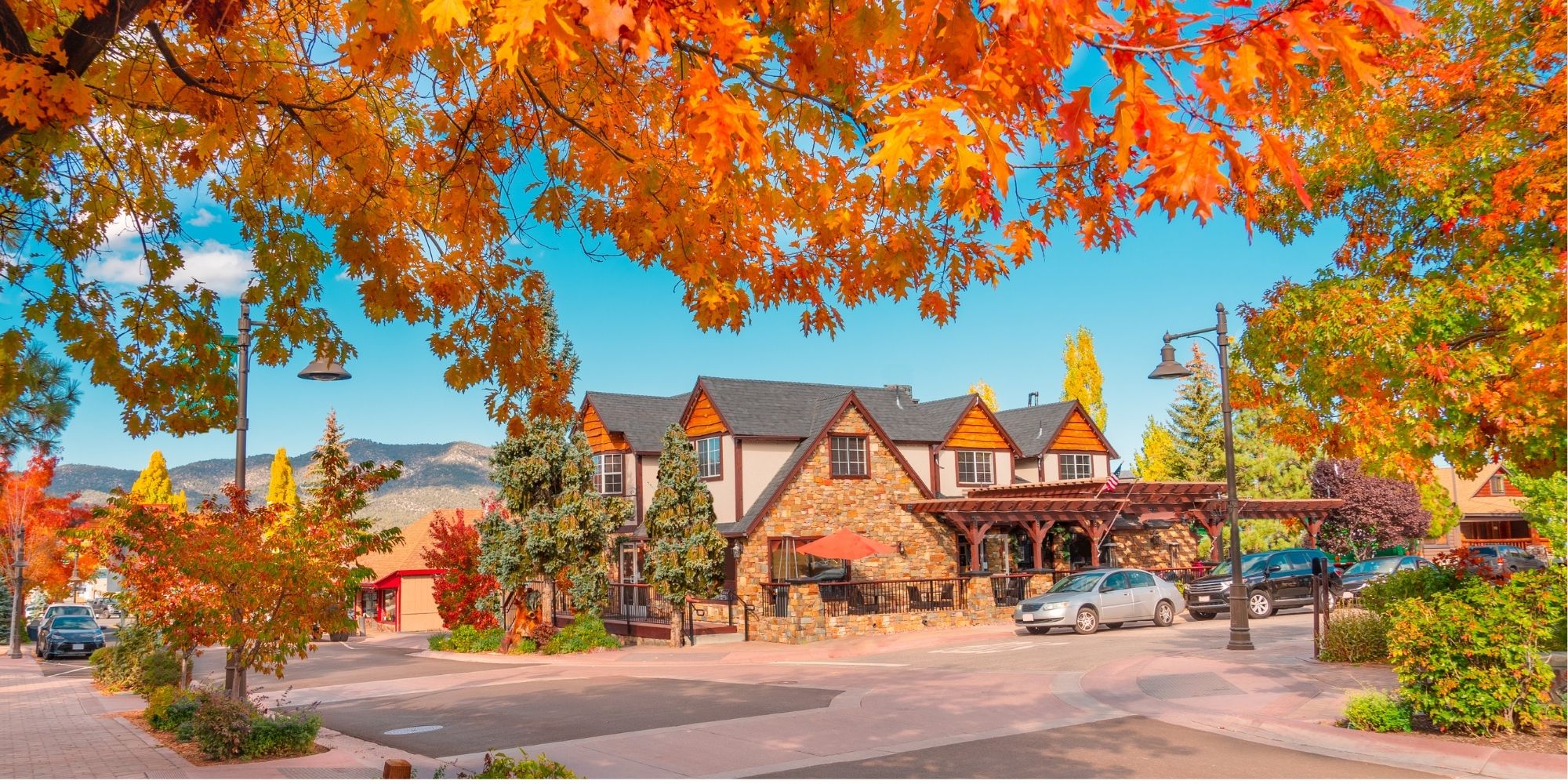
Winter turns Big Bear into a snow-dusted playground from December through February. While Bear Mountain and Snow Summit draw skiers and snowboarders, the lake area itself offers its own quiet magic. On particularly cold years, sheltered coves may freeze enough for ice skating, though always check conditions carefully. The contrast of snow-covered pines against the lake creates a peaceful winter setting perfect for contemplative walks and cozy cabin evenings by the fire.
Spring wakes the mountains with fresh energy as snow melts and feeds the watershed. May brings wildflowers dotting the meadows and trails around the lake. Spring offers that sweet spot of pleasant hiking temperatures, fewer crowds than summer, and the chance to spot wildlife becoming active again—deer, foxes, and countless birds return to their warm-weather routines. The lakeshores grow increasingly lush as plants green up after winter's rest.
Each season at Big Bear Lake writes its own story in the mountains. Your perfect visit depends entirely on what experience you're seeking—from summer swims to autumn hikes, winter wonderlands to spring renewal.
Where to stay in the Big Bear area
When planning your trip to Big Bear Lake, where you rest your head can make or break your outdoor adventure. The area offers everything from rustic campsites to cozy cabins and van-friendly spots. Here's how to find your perfect mountain home base.
Campgrounds and camping tips
Camping puts you right in the middle of Big Bear's natural beauty, with several campgrounds offering different experiences for tent and RV campers.
Serrano Campground sits on the north shore of Big Bear Lake and remains one of the most sought-after spots. You'll find tent and RV sites with lake access for swimming and fishing. The basics are covered with restrooms, showers, and a dump station. Book ahead—this place fills up fast during summer and fall weekends.
For a quieter forest experience, Hanna Flat Campground tucks you into a dense pine forest away from the crowds. The tent and RV sites offer easy access to hiking trails and a nearby creek. Pack everything you need, as amenities are minimal here.
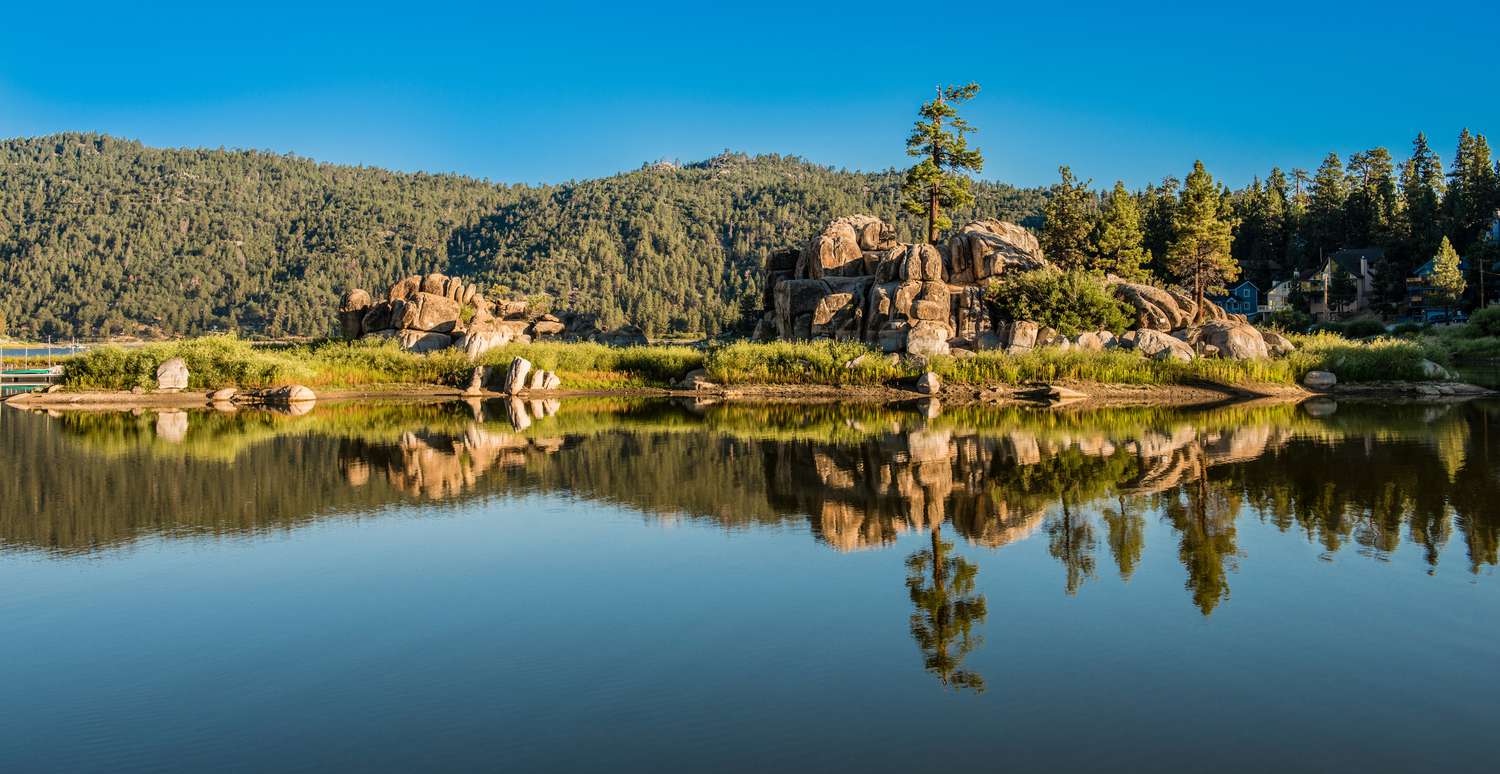
Pineknot Campground gives you the best of both worlds—natural setting with proximity to Big Bear Lake Village. Besides standard tent and RV sites, they offer yurts for campers wanting a bit more comfort. You'll find restrooms, showers, and a camp store, plus quick access to trails and the lake.
Remember to follow Leave No Trace principles while camping at Big Bear. Pack out what you pack in, stick to established campsites, and give wildlife their space.
Cozy cabins and vacation rentals
If sleeping on the ground isn't your thing, Big Bear's cabin scene offers that perfect blend of mountain charm and practical comfort.
Big Bear Vacations manages properties ranging from snug one-bedroom cabins to larger family homes. Many come with cozy touches like wood-burning fireplaces, fully-equipped kitchens, and outdoor hot tubs for soaking under the stars.
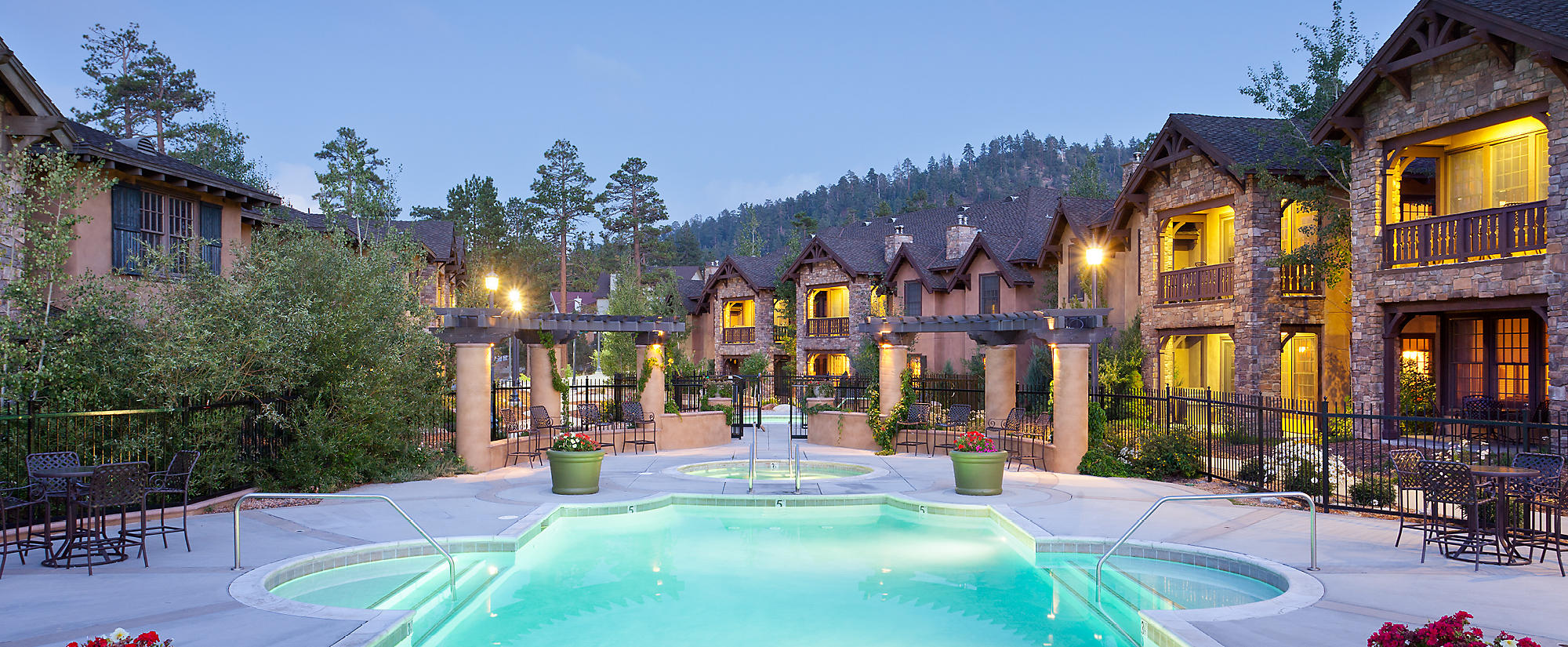
Destination Big Bear offers everything from simple cabins to more upscale homes. Many welcome pets (perfect for those who never leave home without their four-legged hiking buddies) and include essentials like Wi-Fi and outdoor decks.
When browsing cabins, pay attention to location. Some sit lakeside, others perch higher in the mountains with sweeping views, and some nestle close to trailheads. Consider what activities top your list and choose accordingly.
Van-friendly areas and road trip options
The van life and RV crowd will find plenty of welcoming spots around Big Bear Lake, making it a perfect road trip destination.
Big Bear Shores RV Resort caters to those wanting more amenities with their full hookup sites. Beyond the basics, you'll find a clubhouse with game room and fitness center, plus easy lake access.
Boulder Bay Park offers a more low-key option on the western shore with a small RV-friendly campground. You'll find a beach area, picnic tables, and grills—simple but perfect for van travelers wanting to focus on outdoor activities.
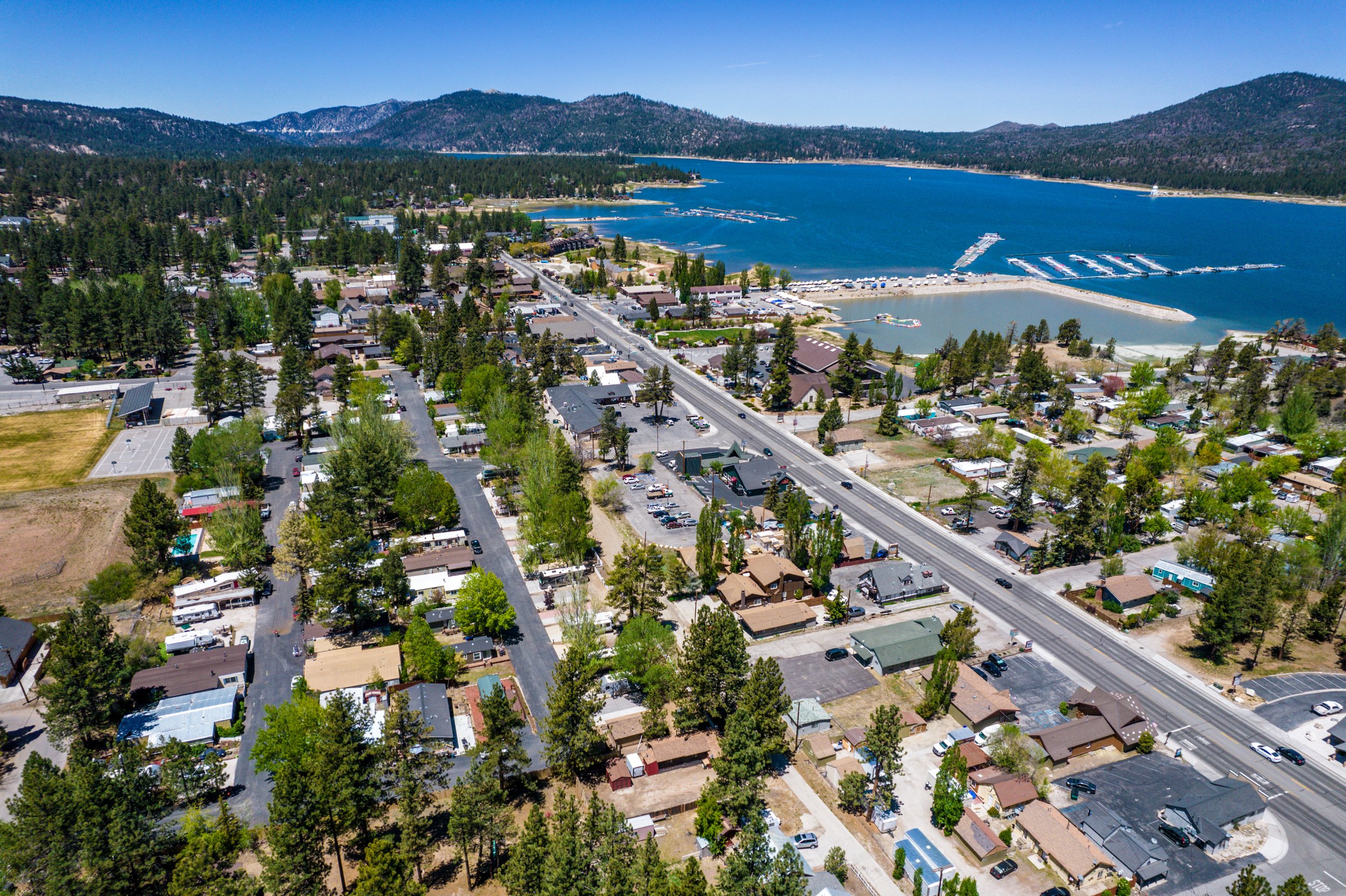
When road-tripping to Big Bear, check ahead about your vehicle size—some areas have restrictions. Also consider what hookups you'll need, especially in winter when temperatures drop. Booking ahead saves headaches, particularly for summer and holiday weekends.
The main advantages of staying in the area include:
Rolling out of bed and onto trails or into the lake
Options for every comfort level and budget
Chances to travel lightly and mindfully in this mountain ecosystem
Conclusion: embrace the great outdoors at Big Bear Lake
Big Bear Lake isn't just another spot on the map—it's a place that stays with you. Whether you're watching the morning mist rise off calm waters, hiking pine-scented trails, or simply sitting lakeside as the sun drops behind the mountains, this alpine gem offers the kind of connection with nature we're always searching for. As you plan your trip, bring your curiosity and leave room for the unexpected. Tread lightly on the trails, chat with locals about their favorite spots, and give yourself permission to slow down. The mountains and waters of Big Bear have been here for centuries—they remind us to take our time. So throw your camping gear in the car, grab those hiking boots, and come discover your own piece of Big Bear magic. The lake is waiting, just as it always has been.
Frequently Asked Questions
Is it OK to swim in Big Bear Lake?
Yes, swimming in Big Bear Lake is perfectly fine, especially during summer. The lake's clean, clear waters make for refreshing dips when temperatures rise. Most swimmers head to Big Bear Lake Swim Beach, Boulder Bay Park, or Meadow Park – all spots with designated swimming areas. During peak season, lifeguards keep watch, and you'll find convenient amenities like picnic tables and restrooms nearby. Just check current water conditions before jumping in – lake levels and quality can shift throughout the season.
What's the difference between Big Bear and Big Bear Lake?
Big Bear refers to the entire mountain region and community nestled in the San Bernardino Mountains, while Big Bear Lake is specifically the seven-mile reservoir at its heart. The town of Big Bear Lake sits along the south shore, serving as the main visitor hub with shops, restaurants, and outfitters. When locals mention "going to Big Bear," they mean the whole area, including surrounding forest, trails, and smaller communities – not just the lake itself.
What is Big Bear Lake famous for?
Big Bear Lake stands out for its crystal-clear alpine waters surrounded by mountain peaks and pine forests. Outdoor enthusiasts flock here for water activities like kayaking and paddleboarding in summer, plus exceptional hiking on trails that offer sweeping lake views. Wildlife watchers often spot bald eagles, ospreys and native fish. Come winter, the area transforms into a snow sports destination with nearby Bear Mountain and Snow Summit drawing skiers and snowboarders. The mix of accessible wilderness with small-town charm makes it a year-round draw for nature lovers.
Is it worth it to go to Big Bear Lake?
For outdoor explorers and nature lovers – absolutely. Big Bear Lake offers that perfect blend of accessible wilderness without the crowds of more famous mountain destinations. The alpine setting provides a complete change of scenery just a couple hours from Southern California cities, with temperatures typically 15-20 degrees cooler than the valleys below.
